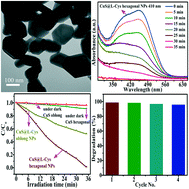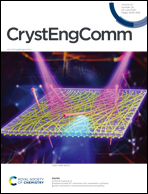Designing novel morphologies of l-cysteine surface capped 2D covellite (CuS) nanoplates to study the effect of CuS morphologies on dye degradation rate under visible light†
Abstract
Pure self-assembled L-cysteine stabilized covellite nanoplates (CuS@L-Cys NPs) with the best control over size, phase purity structure, morphology, and electrochemical properties were synthesized using a facile, template-free hydrothermal route. The effects of temperature (100–180 °C), reaction time (8–24 h), pH of reaction medium (7–14), concentration of base (0.1–2.4 mL NH3) and concentration of thiourea (1–4 mmol) on the morphologies of CuS@L-Cys nanoplates were studied. The photocatalytic performance of CuS@L-Cys NPs under visible light was studied using methyl orange (MO) as a model dye. CuS@L-Cys NPs were reused successfully for the photodegradation of dye due to the recycling ability of CuS@L-Cys NPs. The hydroxyl radicals (˙OH) generated by CuS@L-Cys NPs were detected using terephthalic acid (TA) as a probe molecule through the photoluminescence (PL) technique. The successful capping of L-Cys on the surface of CuS NPs was confirmed by FTIR spectroscopy. The BET surface areas of the hexagonal CuS@L-Cys NPs and oblong CuS@L-Cys NPs were measured to be 11.87 and 5.66 m2 g−1, respectively. The optical band gaps of the hexagonal CuS@L-Cys NPs (2.0 eV) and oblong CuS@L-Cys NPs (2.04 eV) were determined according to direct bandgap calculations. These results support the presence of hexagonal CuS@L-Cys NP catalysts as efficient accelerators of the photodegradation of MO. Furthermore, the L-cysteine (L-Cys) protective layer could efficiently alleviate the photocorrosion of CuS, giving rise to excellent stability. The high photocatalytic activity of the hexagonal CuS@L-Cys NPs can be ascribed to the reduction of photoinduced electron–hole pair recombination and high specific surface area, as confirmed by BET for other representative samples.



 Please wait while we load your content...
Please wait while we load your content...